1996 CHEVROLET ASTRO wheel
[x] Cancel search: wheelPage 79 of 372
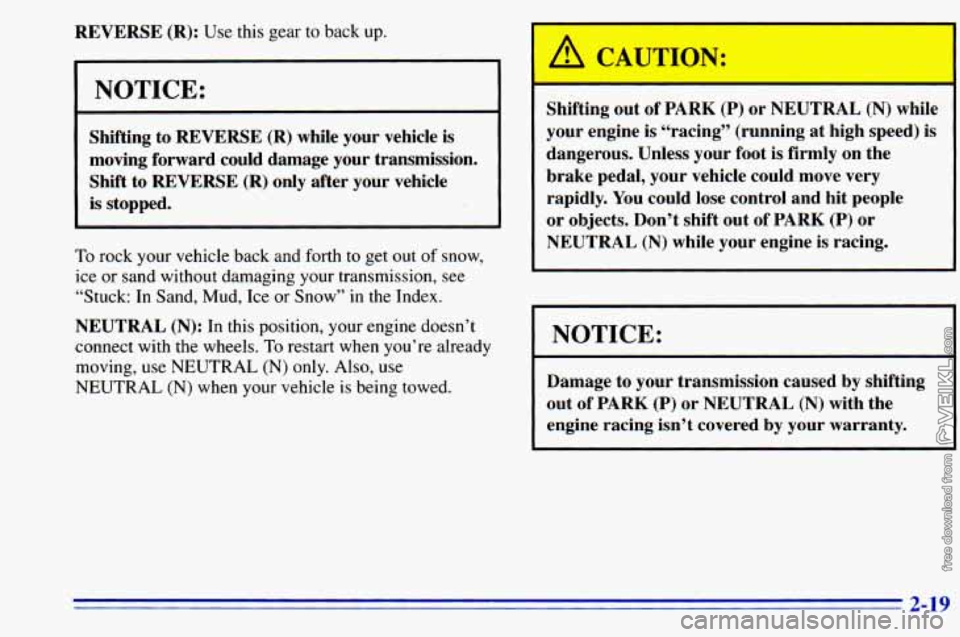
REVERSE (R): Use this gear to back up.
1 NOTICE:
Shifting to REVERSE (R) while your vehicle is
moving forward could damage your transmission.
Shift to
REVERSE (R) only after your vehicle
is stopped.
To rock your vehicle back and forth to get out of snow,
ice or sand without damaging your transmission, see
“Stuck: In Sand, Mud, Ice or Snow” in the Index.
NEUTRAL (N): In this position, your engine doesn’t
connect with the wheels.
To restart when you’re already
moving, use NEUTRAL
(N) only. Also, use
NEUTRAL (N) when your vehicle is being towed.
A CAUTION:
Shifting out of PARK (P) or NEUTRAL (N) while
your engine is “racing” (running at high speed) is
dangerous. Unless your foot is firmly on the
brake pedal, your vehicle could move very
rapidly. You could lose control and hit people
or objects. Don’t shift out of
PARK (P) or
NEUTRAL (N) while your engine is racing.
I NOTICE:
Damage to your transmission caused by shifting
out of
PARK (P) or NEUTRAL (N) with the
engine racing isn’t covered
by your warranty.
Page 80 of 372

DRIVE (D): This position is for normal driving. If you
need more power for passing, and you’re:
Going less than about 35 mph (56 km/h), push your
accelerator pedal about halfway down.
Going about 35 mph (56 km/h) or more, push the
accelerator pedal all the way down. You’ll shift
down to
the next gear and have more power.
DRIVE
(D) should be used for normal trailer towing.
THIRD
(3): This position is also used for normal
driving, however it offers more power and lower
fuel
economy than DRIVE (D). You should use THIRD (3)
when carrying a heavy load or driving on steep hills.
SECOND
(2): This position gives you more power but
lower fuel economy.
You can use SECOND (2) on hills.
It can help control your speed
as you go down steep
mountain roads, but
then you would also want to use
your brakes off and on.
If you manually select SECOND
(2)’ the transmission
will drive
in second gear. You may use this feature
for reducing torque to
the rear wheels when you are
trying to start your vehicle from a stop on slippery
road surfaces. FIRST
(1): This
position gives you even more power
(but lower
fuel economy) than SECOND (2). You can .
use it on very steep hills, or in deep snow or mud. If the
selector lever is put
in FIRST (1)’ the transmission
won’t shift
into first gear until the vehicle is going
slowly enough.
NOTICE:
If your rear wheels can’t rotate, don’t try to
drive. This might happen if you were stuck in
very deep sand or mud or were up against
a solid
object. You could damage your transmission or
transfer case or both.
Also, if you stop when going uphill, don’t hold
your vehicle there with only the accelerator
pedal. This could overheat and damage the
transmission. Use your brakes or shift into
PARK
(P) to hold your vehicle in position on
a hill.
2-20
Page 81 of 372
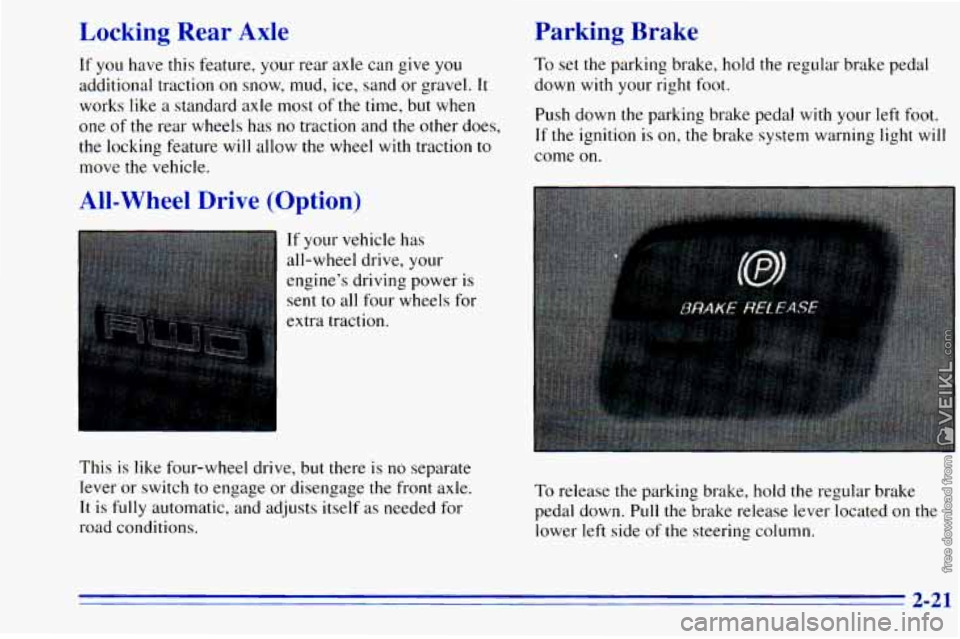
Locking Rear Axle
If you have this feature, your rear axle can give you
additional traction on snow, mud, ice, sand or gravel.
It
works like a standard axle most of the time, but when
one
of the rear wheels has no traction and the other does,
the locking feature will allow
the wheel with traction to
move the vehicle.
All-Wheel Drive (Option)
If your vehicle has
all-wheel drive, your
engine’s driving power
is
sent to all four wheels for
extra traction.
Parking Brake
To set the parking brake, hold the regular brake pedal
down with your right foot.
Push down the parking brake pedal with
your left foot.
If the ignition is on, the brake system warning light will
come on.
This is like four-wheel drive, but there is
no separate
lever or switch
to engage or disengage the front axle.
It
is fully automatic, and adjusts itself as needed for
road conditions.
To release the parking brake, hold the regular brake
pedal down. Pull the brake release lever located
on the
lower left side of the steering column.
2-21
Page 89 of 372

Horn
To sound the horn, press the horn symbols on the
steering wheel.
Tilt Wheel (Option)
Turn' SignaVMultifunction Lever
A tilt steering wheel allows you to adjust the steering
wheel before you drive.
You can also raise it to the highest level to give your
legs more room when you exit and enter the vehicle.
I ' The lever on the driver's side of the steering column
includes your:
0 Turn and Lane Change Signals
0 Headlamp High/Low Beam Changer
0 Windshield Wipers
0 Windshield Washer
To tilt t& wheel, hold the steering wheel and pull the ' 0 Cruise Control (Option)
j lever. Move the steering wheel to a comfortable level,
I then release the lever to lock the wheel in place. I
2-29
Page 92 of 372
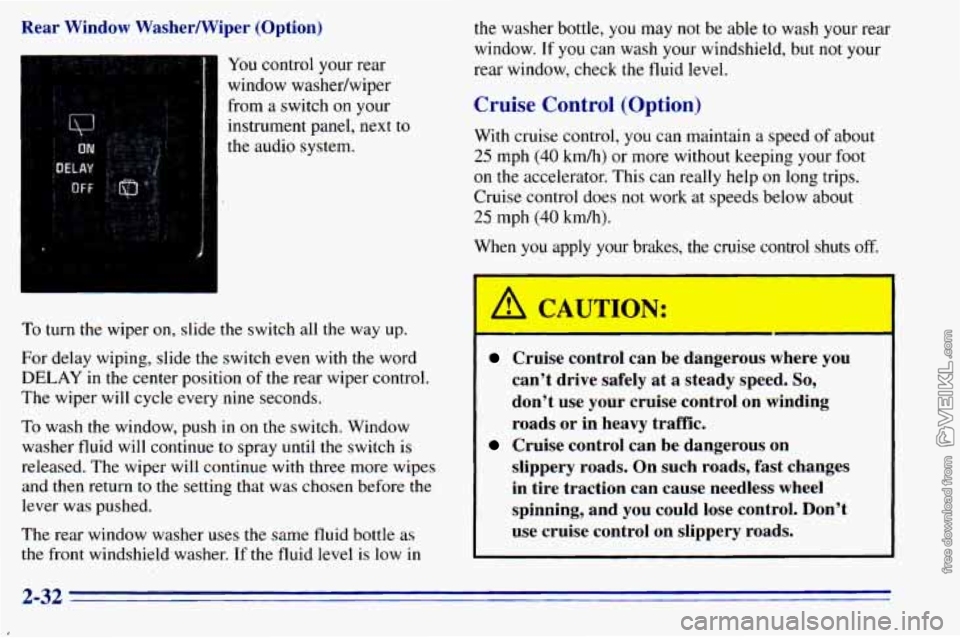
Rear Window Washermiper (Option) from
a switch on your
instrument panel, next to
the audio system.
To turn the wiper on, slide the switch all the way up.
For delay wiping, slide the switch even with
the word
DELAY in the center position of the rear wiper control.
The wiper will cycle every nine seconds.
To wash the window, push in on the switch. Window
washer fluid will continue
to spray until the switch is
released. The wiper will continue with three more wipes
and then return
to the setting that was chosen before the
lever was pushed.
The rear window washer uses the same fluid bottle as
the front windshield washer.
If the fluid level is low in
the washer bottle, you may not be able to wash your rear
window.
If you can wash your windshield, but not your
rear window, check
the fluid level.
Cruise Control (Option)
With cruise control, you can maintain a speed of about
25 mph (40 kmh) or more without keeping your foot
on the accelerator. This can really help on long trips.
Cruise control does not work at speeds below about
25 mph (40 km/h).
When you apply
y sakes, the *
A CAUTION:
#e con 1 sh i off.
Cruise control can be dal-,-- JUS wher - JOU
can’t drive safely at a steady speed. So,
don’t use your cruise control on winding
roads or in heavy traffic.
slippery roads. On such roads, fast changes
in tire traction can cause needless wheel
spinning, and you could lose control. Don’t
use cruise control on slippery roads.
Cruise control can be dangerous on
2-32
Page 161 of 372
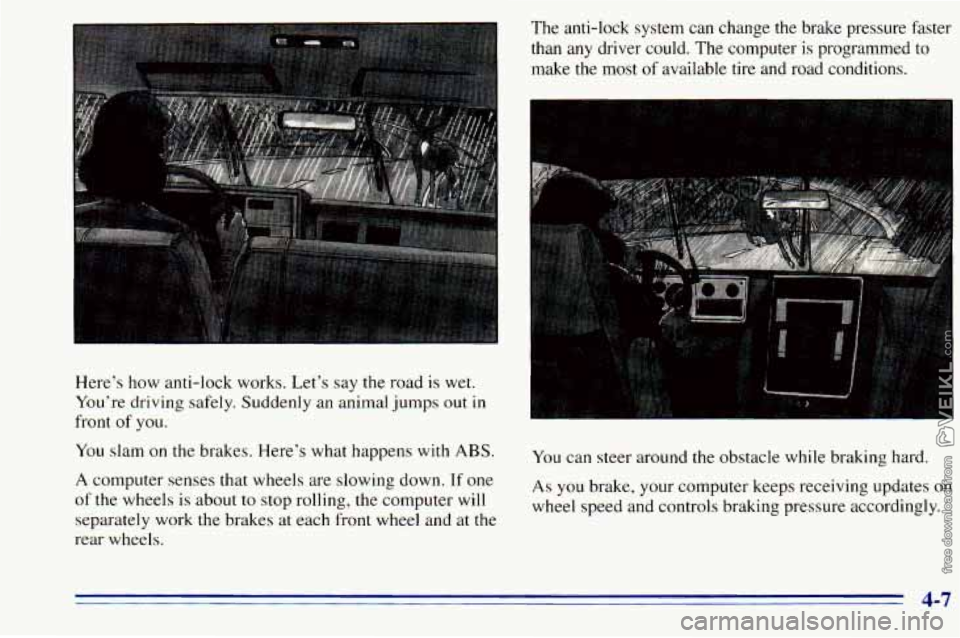
Here’s how anti-lock works. Let’s say the road is wet.
You’re driving safely. Suddenly an animal jumps out in
front
of you.
You slam on the brakes. Here’s what happens with
ABS.
A computer senses that wheels are slowing down. If one
of the wheels is about to stop rolling, the computer will
separately work the brakes at each front wheel and at the
rear wheels. The
anti-lock system can change the brake pressure faster
than any driver could. The computer is programmed to
make the most
of available tire and road conditions.
You can steer around the obstacle while braking hard.
As you brake, your computer keeps receiving updates on
wheel speed and controls braking pressure accordingly.
4-7
Page 162 of 372
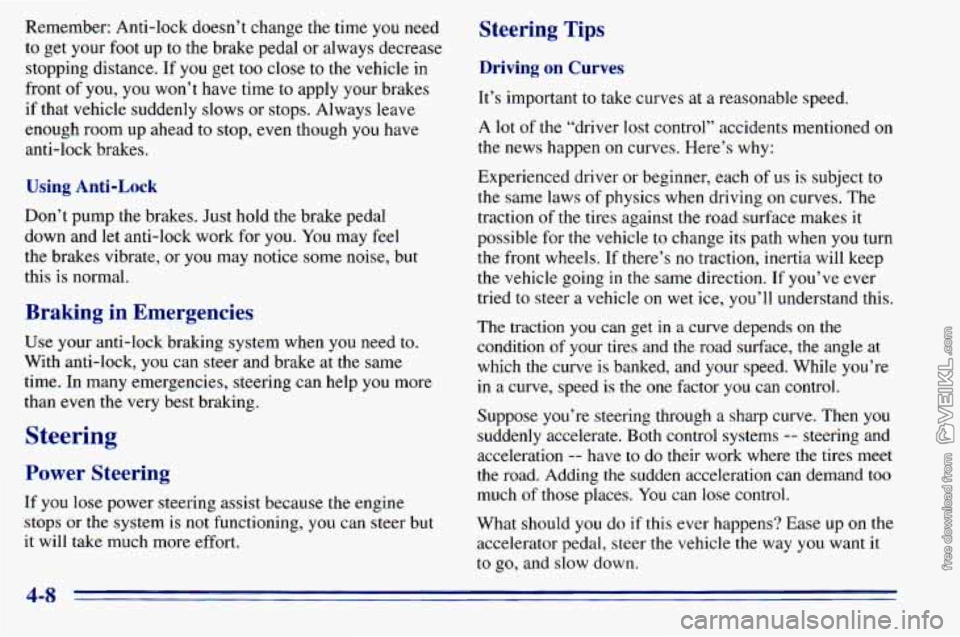
Remember: Anti-lock doesn’t change the time you need
to get your foot up
to the brake pedal or always decrease
stopping distance. If you get too close
to the vehicle in
front
of you, you won’t have time to apply your brakes
if that vehicle suddenly slows or stops. Always leave
enough room up ahead
to stop, even though you have
anti-lock brakes.
Using Anti-Lock
Don’t pump the brakes. Just hold the brake pedal
down and let anti-lock work for you. You may feel
the brakes vibrate, or you
may notice some noise, but
this
is normal.
Braking in Emergencies
Use your anti-lock braking system when you need to.
With anti-lock, you can steer and brake at the same
time. In many emergencies, steering can help you more
than even the very best braking.
Steering
Power Steering
If you lose power steering assist because the engine
stops
or the system is not functioning, you can steer but
it will take much more effort,
Steering Tips
Driving on Curves
It’s important to take curves at a reasonable speed.
A lot of the “driver lost control’’ accidents mentioned on
the news happen on curves. Here’s why:
Experienced driver or beginner, each of us is subject to
the same laws of physics when driving
on curves. The
traction
of the tires against the road surface makes it
possible for the vehicle to change its path when
you turn
the front wheels.
If there’s no traction, inertia will keep
the vehicle going
in the same direction. If you’ve ever
tried to steer a vehicle
on wet ice, you’ll understand this.
The traction
you can get in a curve depends on the
condition of your tires and the road surface, the angle
at
which the curve is banked, and your speed. While you’re
in a curve, speed is the one factor
you can control.
Suppose you’re steering through a sharp curve. Then
you
suddenly accelerate. Both control systems -- steering and
acceleration
-- have to do their work where the tires meet
the road. Adding the sudden acceleration can demand too
much
of those places. You can lose control.
What should you do
if this ever happens? Ease up on the
accelerator
pedal, steer the vehicle the way you want it
to
go, and slow down.
4-8
Page 163 of 372
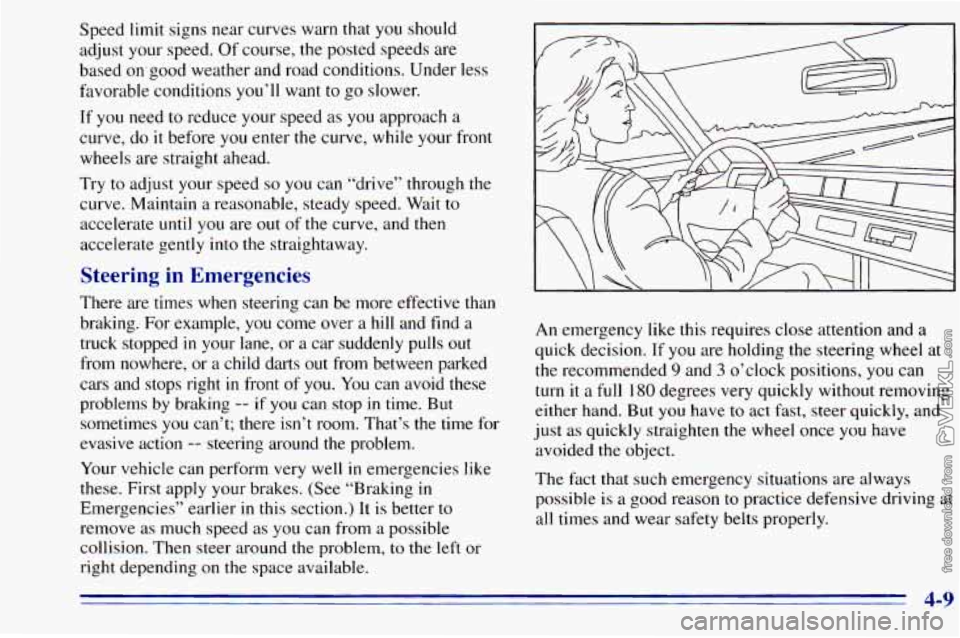
Speed limit signs near curves warn that you should
adjust your speed. Of course, the posted speeds are
based on,good weather and road conditions. Under less
favorable conditions
you’ll want to go slower.
If you need to reduce
your speed as you approach a
curve, do it before
you enter the curve, while your front
wheels are straight ahead.
Try
to adjust your speed so you can “drive” through the
curve. Maintain a reasonable, steady speed. Wait
to
accelerate until you are out of the curve, and then
accelerate gently
into the straightaway.
Steering in Emergencies
There are times when steering can be more effective than
braking. For example, you come over a
hill and find a
truck stopped in your lane, or a car suddenly pulls out
from nowhere, or a child darts out from between parked
cars and stops right
in front of you. You can avoid these
problems
by braking -- if you can stop in time. But
sometimes you can’t; there isn’t room. That’s the time for
evasive action
-- steering around the problem.
Your vehicle can perform very well
in emergencies like
these. First apply your brakes. (See “Braking
in
Emergencies’’ earlier in this section.) It is better to
remove as much speed as you can from a possible
collision. Then steer around the problem,
to the left or
right depending on
the space available. An
emergency like this requires close attention and a
quick decision.
If you are holding the steering wheel at
the recommended 9 and 3 o’clock positions, you can
turn
it a full 180 degrees very quickly without removing
either hand. But you have
to act fast, steer quickly, and
just as quickly straighten the wheel once
you have
avoided the object.
The fact that such emergency situations are always
possible is a good reason
to practice defensive driving at
all times and wear safety belts properly.
4-9